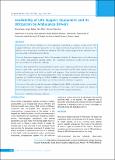Please use this identifier to cite or link to this item:
https://hdl.handle.net/20.500.14356/1674Full metadata record
| DC Field | Value | Language |
|---|---|---|
| dc.contributor.author | Acharya, Rija | - |
| dc.contributor.author | Badhu, Angur | - |
| dc.contributor.author | Shah, Tara | - |
| dc.contributor.author | Shrestha, Sharmila | - |
| dc.date.accessioned | 2023-05-18T06:23:08Z | - |
| dc.date.available | 2023-05-18T06:23:08Z | - |
| dc.date.issued | 2017 | - |
| dc.identifier.citation | AcharyaR., BadhuA., ShahT., & ShresthaS. (2017). Availability of Life Support Equipment and its Utilization by Ambulance Drivers. Journal of Nepal Health Research Council, 15(2), 182-186. https://doi.org/10.33314/jnhrc.v15i2.1056 | en_US |
| dc.identifier.issn | Print ISSN: 1727-5482; Online ISSN: 1999-6217 | - |
| dc.identifier.uri | http://103.69.126.140:8080/handle/20.500.14356/1674 | - |
| dc.description | Short Communication | en_US |
| dc.description.abstract | Abstract Background: An effective ambulance is a vital requirement for providing an emergency medical service. Well-equipped ambulances with trained paramedics can save many lives during the golden hours of trauma care. The objective was to document the availability and utilization of basic life support equipment in the ambulances and to assess knowledge on first aid among the drivers. Methods: Descriptive design was used. Total of 109 ambulances linked to B.P. Koirala Institute of Health Sciences were enrolled using purposive sampling method. Self- constructed observation checklist and semi structured interview schedule was used for data collection. Results: More than half of the respondents had less than five years of experience and were not trained in first aid. About two-third of the respondents had adequate knowledge on first aid. About 90% of the ambulance had oxygen cylinder and adult oxygen mask which was ‘usually’ used equipment. More than half of ambulance had equipment less than 23% as compared to that of national guidelines. There was significant association of knowledge with the experience (p = 0.004) and training (p = 0.001). Availability of equipment was associated with training received (p = 0.007),organization (p= 0.032)and district (p = 0.023) in which the ambulance is registered. Conclusions: The study concludes that maximum ambulance linked to BPKIHS, Nepal did not have even one fourth of the equipment for basic life support. Equipment usually used was oxygen cylinder and oxygen mask. Majority of driver had adequate knowledge on first aid and it was associated with training and experience. Keywords: Availability; knowledge; utilization. | en_US |
| dc.language.iso | en | en_US |
| dc.publisher | Nepal Health Research Council | en_US |
| dc.relation.ispartofseries | May-Aug, 2017;1056 | - |
| dc.subject | Availability | en_US |
| dc.subject | Knowledge | en_US |
| dc.subject | Utilization | en_US |
| dc.title | Availability of Life Support Equipment and its Utilization by Ambulance Drivers | en_US |
| dc.type | Journal Article | en_US |
| Appears in Collections: | Vol 5 No 2 Issue 36 May-Aug 2017 | |
Files in This Item:
| File | Description | Size | Format | |
|---|---|---|---|---|
| 1056-Article Text-2335-1-10-20170908.pdf | Fulltext Download | 210.64 kB | Adobe PDF |  View/Open |
Items in DSpace are protected by copyright, with all rights reserved, unless otherwise indicated.
